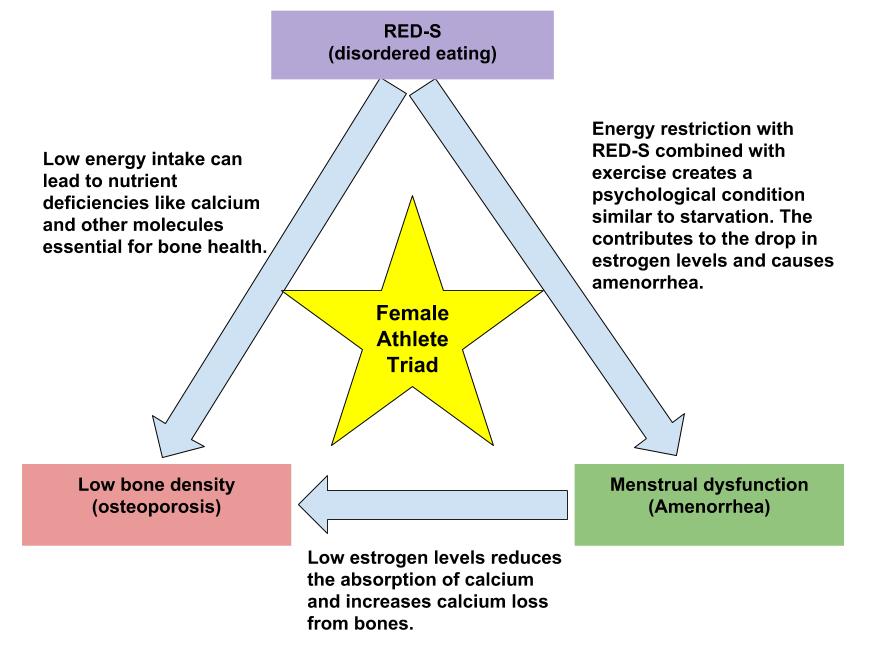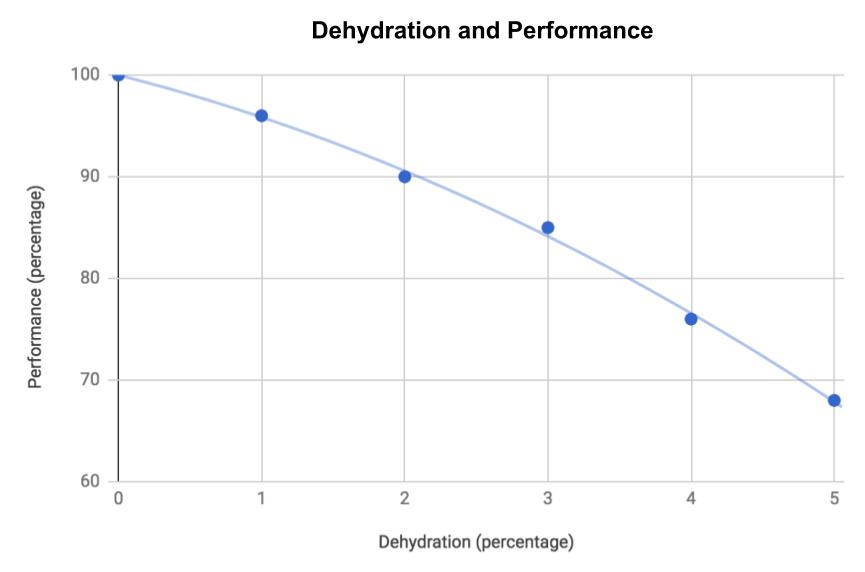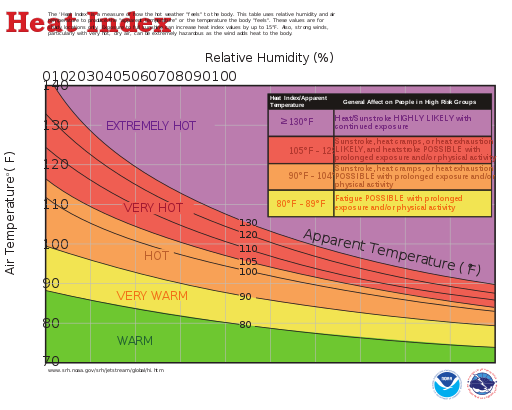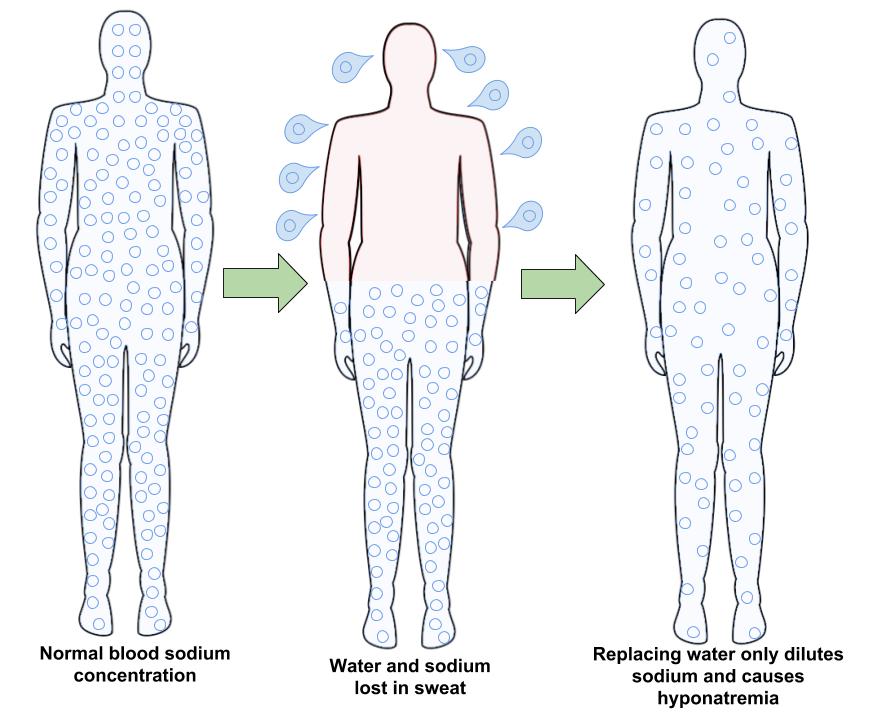3.2.2. Sports Nutrition
Nutrient Needs for Athletes
Nutrition is essential to your performance during all types of exercise. The foods consumed in your diet are used to provide the body with enough energy to fuel an activity regardless of the intensity of activity. Athletes have different nutritional needs to support the vigorous level they compete and practice at.
Energy Needs
To determine an athletes nutritional needs, it is important to revisit the concept of energy metabolism. Energy intake is the foundation of an athlete’s diet because it supports optimal body functions, determines the amount of intake of macronutrients and micronutrients, and assists in the maintaining of body composition. Energy needs for athletes increase depending on their energy expenditure. The energy expended during physical activity are contingent on the intensity, duration, and frequency of the exercise. Competitive athletes may need 3,000 to over 5,000 calories daily compared to a typical inactive individual who needs about 2,000 calories per day. Energy needs are also affected by an individual’s gender, age, and weight. Weight-bearing exercises, such as running, burn more calories per hour than non-weight bearing exercises, such as swimming. Weight-bearing exercises requires your body to move against gravity which requires more energy. Men are also able to burn more calories than women for the same activity because they have more muscle mass which requires more energy to support and move around.[1]
Body weight and composition can have a tremendous impact on exercise performance. Body weight and composition are considered the focal points of physique for athletes because they are the able to be manipulated the most. Energy intake can play a role in manipulating the physiques for athletes. For individuals competing in sports such as football and weight lifting, having a large amount of muscle mass and increased body weight may be beneficial. This can be obtained through a combination of increased energy intake, and protein. Although certain physiques are more advantageous for specific sports, it is important to remember that a single and rigid “optimal” body composition is not recommended for any group of athletes.[2]
Macronutrient Needs
The composition of macronutrients in the diet is a key factor in maximizing performance for athletes. Carbohydrates are an important fuel source for the brain and muscle during exercise. Carbohydrate storage in the liver and muscle cells are relatively limited and therefore it is important for athletes to consume enough carbohydrates from their diet. Carbohydrate needs should increase about 3-10 g/kg/day depending on the type of training or competition.[3] See Table 3.2.2.1 “Daily Needs for Carbohydrate Fuel” for carbohydrate needs for athletes depending on the intensity of the exercise.
Table 3.2.2.1 Daily Needs for Carbohydrate Fuel
| Activity level | Example of exercise | Increase of carbohydrate (g/kg of athlete’s body weight/day) |
| Light | Low intensity or skill based activities | 3-5 |
| Moderate | Moderate exercise program (about 1 hour per day) | 5-7 |
| High | Endurance program (about 1-3 hours per day of moderate to high intensity exercise) | 6-10 |
| Very high | Extreme commitment (4-5 hours per day of moderate to high intensity exercise) | 8-12 |
Note: Daily need for carbohydrates increases with the intensity of activity level. Source: Nutrition and Athletic Performance. American College of Sports Medicine.Medicine & Science in Sports & Exercise. 2016; 48(3), 543- 568. https://journals.lww.com/acsm-msse/Fulltext/2016/03000/Nutrition_and_Athletic_Performance.25.aspx. Accessed March 17, 2018.
Fat is a necessary component of a healthy diet to provide energy, essential fatty acids and to facilitate the absorption of fat-soluble vitamins. Athletes are recommended to consume the same amount of fat in the diet as the general population, 20-35% of their energy intake. Although these recommendations are in accordance with public health guidelines, athletes should individualize their needs based on their training level and body composition goals. Athletes who choose to excessively restrict their fat intake in an effort to lose body weight or improve body composition should ensure they are still getting the minimum recommended amount of fat. Fat intakes below 20% of energy intake will reduce the intake of fat-soluble vitamins and essential fatty acids, especially omega 3’s.[4]
Although protein accounts for only about 5% of energy expended, dietary protein is necessary to support metabolic reactions (that generate ATP), and to help muscles with maintenance, growth, and repair. During exercise, these metabolic reactions for generating ATP rely heavily on proteins such as enzymes and transport proteins. It is recommended that athletes consume 1.2 to 2.0 g/kg/day of proteins in order to support these functions. Higher intakes may also be needed for short periods of intense training or when reducing energy intake.[5] See Table 3.2.2.2 “Recommended Daily Protein Intakes for Athletes” below for a better representation of protein needs depending on extent of training and dietary sources.
Table 3.2.2.2 Recommended Protein Intakes for Individuals
| Group | Daily protein intake (g per kg body weight) |
| Most adults | 0.8 |
| Endurance athletes | 1.2 to 1.4 |
| Vegetarian endurance athletes | 1.3 to 1.5 |
| Strength athletes | 1.6 to 1.7 |
| Vegetarian strength athletes | 1.7 to 1.8 |
Note: Amount of protein intake increases for endurance and strength athletes. Vegetarian athletes require the highest amounts of protein. Source: Dietary Reference Intakes, 2002 ACSM/ADA/Dietitians of Canada Position Statement: Nutrition & Athletic Performance, 2001. Accessed March 17, 2018.
It is important to consume adequate amounts of protein and to understand that the quality of the protein consumed affects the amount needed. High protein foods such as meats, dairy, and eggs contain all of the essential amino acids in relative amounts that most efficiently meet the body’s needs for growth, maintenance and repair of muscles. Vegetarian diets contain protein that has lower digestibility and amino acid patterns that do not match human needs as closely as most animal proteins. To compensate for this as well as the fact that plant food protein sources also contain higher amounts of fiber, higher protein intakes are recommended for vegetarian athletes. (See Table 3.2.2.2 “Recommended Daily Protein Intakes for Individuals” )
Micronutrient Needs
Vitamins and minerals are essential for energy metabolism, the delivery of oxygen, protection against oxidative damage, and the repair of body structures. When exercise increases, the amount of many vitamins and minerals needed are also increased due to the excess loss in nutrients. Currently, there is not special micronutrient recommendations made for athletes but most athletes will meet their needs by consuming a balanced diet that meets their energy needs. Because the energy needs of athletes increase, they often consume extra vitamins and minerals. The major micronutrients of concern for athletes include iron, calcium, vitamin D, and some antioxidants.[6]
Common Nutrient Deficiencies for Athletes
Energy deficiency
For athletes, consuming sufficient amounts of calories to support their energy expenditure is vital to maintain health and body functions. When the energy intake for athletes does not meet the high demands of exercise, a syndrome referred to as relative energy deficiency in sport (RED-S) occurs. RED-S has a negative effect on performance and health in both male and female athletes as shown in “Relative Energy Deficiency in Sport Effects”. Athletes in sports with weight classes, such as wrestling, may put their health at risk by rapid weight loss in order to hit a specific weight for a match. These athletes are vulnerable to eating disorders due to sporadic dieting (several of which will restrict energy intake). The long term effects of these practices can not only impair performance but also have serious repercussions such as heart and kidney function, temperature regulation and electrolyte balance problems.
Of the RED-S consequences that occur from an energy intake deficiency, the two health effects that are of the greatest concern to female athletes are menstrual dysfunction and decreased bone density. Menstrual dysfunction and low bone density symptoms of RED-S can create hormonal imbalances that are described in Figure 3.3.2.1 “The Female Athlete Triad”. In today’s society, there is increasing pressure to be extremely thin that some females take exercise too far. The low energy intakes will lead to the female athlete triad that causes bone loss, stoppage of menstrual periods, and eating disorders.[7]
Figure 3.3.2.1 The Female Athlete Triad

Iron
Iron deficiency is very common in athletes. During exercise, iron-containing proteins like hemoglobin and myoglobin are needed in great amounts. An iron deficiency can impair muscle function to limit work capacity leading to compromised training performance. Some athletes in intense training may have an increase in iron losses through sweat, urine, and feces. Iron losses are greater in females than males due to the iron lost in blood every menstrual cycle. Female athletes, distance runners and vegetarians are at the greatest risk for developing iron deficiency.[8] See Table 3.2.2.3. “The Potential Iron Loss in Endurance Athletes” for the potential amounts of iron loss each day in male and female athletes. An increased recommendation for both genders are shown below. These recommendations are based on the assumption that iron has a 10% absorption efficiency. As noted above, women athletes have a greater iron loss due to menstruation and therefore must increase their dietary needs more than male athletes.
Table 3.2.2.3 The Potential Iron Loss in Endurance Athletes
| Approximate daily iron losses in endurance athletes (mg/day) and increased dietary need | ||
| Male | Female | |
| Sedentary | 1 | 1.5 |
| Athlete | 1.8 | 2.5 |
Note: Iron loss is greatest in endurance athletes, particularly in females, increasing their daily needs. Source: Weaver CM, Rajaram S.Exercise and iron status. J Nutr. 1992 Mar;122(3 Suppl):782-7. https://www.ncbi.nlm.nih.gov/pubmed/1542048. Accessed March 23, 2018.
Sports anemia, which is different from iron deficiency anemia is an adaptation to training for athletes. Excessive training causes the blood volume to expand in order to increase the amount of oxygen delivered to the muscles. During sports anemia, the synthesis of red blood cells lags behind the increase in blood volume which results in a decreased percentage of blood volume that is red blood cells. The total amount of red blood cells remains the same or may increase slightly to continue the transport of oxygen. Eventually as training progresses, the amount of red blood cells will increase to catch up with the total blood volume.
Vitamin D and Calcium
Vitamin D regulates the calcium and phosphorus absorption and metabolism and plays a key role in maintaining optimal bone health. There is also growing evidence that vitamin D is important for other aspect of athletic performance such as injury prevention, rehabilitation, and muscle metabolism. Individuals who primarily practice indoors are at a larger risk for a vitamin D deficiency and should ensure they are consuming foods high in vitamin D to maintain sufficient vitamin D status.[9]
Calcium is especially important for the growth, maintenance, and repair of bone tissue. Low calcium intake occurs in athletes with RED-S, menstrual dysfunction, and those who avoid dairy products. A diet inadequate in calcium increases the risk for low bone mineral density which ultimately leads to stress fractures.
Antioxidant Nutrients
Antioxidant nutrients play an important role in protecting cell membranes from oxidative damage. During exercise, the amount of oxygen used by the muscles increases and can produce free radicals which causes an increase in antioxidant systems in the the body. These antioxidant systems rely on the dietary antioxidants such as beta-carotene, vitamin C, vitamin E, and selenium that can be obtained through a nutrient dense diet.
Water and Electrolyte Needs
During exercise, being appropriately hydrated contributes to performance. Water is needed to cool the body, transport oxygen and nutrients, and remove waste products from the muscles. Water needs are increased during exercise due to the extra water losses through evaporation and sweat. Dehydration can occur when there is inadequate water levels in the body and can be very hazardous to the health of an individual. As the severity of dehydration increases, the exercise performance of an individual will begin to decline (see Figure 3.3.2.2 “Dehydration Effect on Exercise Performance”). It is important to continue to consume water before, during and after exercise to avoid dehydration as much as possible.
Figure 3.3.2.2 Dehydration Effect on Exercise Performance

During exercise, thirst is not a reliable short term indicator of the body’s needs as it typically is not enough to replace the water loss. Even with the constant replenishing of water throughout an exercise, it may not be possible to drink enough water to compensate for the losses. Dehydration occurs when the total loss of water is so significant that the total blood volume decreases which leads to the reduction of oxygen and nutrients transported to the muscle cells. A decreased blood volume also reduces the blood flow to the skin and the production of sweat which can increase the body temperature. As a result, the risk of heat related illnesses increases.
Heat cramps are one of the heat related illnesses that can occur during or after exercise. Heat cramps are involuntary muscle spasms that usually involve the muscle being exercised, which causes by an imbalance of electrolytes, usually sodium. Heat exhaustion is caused by the loss of water decreasing the blood volume so much that it is not possible to cool the body as well as provide oxygen and nutrients to the active muscles. Symptoms that arise from heat exhaustion may include low blood pressure, disorientation, profuse sweating, and fainting. Heat exhaustion can progress further if exercise continues into a heat stroke. A heat stroke is the most serious form of heat related illnesses that can occur. During a heat stroke, the internal body temperature rises above 105℉ which causes the brain’s temperature-regulatory center to shut down. When the brain’s temperature regulatory center shuts down, an individual is unable to sweat regardless of their internal body temperature rising. Other symptoms that arise are dry skin, extreme confusion, and unconsciousness. A heat stroke requires immediate medical attention.
The external temperature during exercise can also play a role in the risk of heat related illnesses. As the external temperature increases, it becomes more difficult for the body to dissipate heat. As humidity also increases, the body is unable to cool itself through evaporation. The Heat Index is a measure of how hot the body feels when humidity is added to the air temperature (see Figure 3.3.2.3 “The Heat Index”).
Figure 3.3.2.3 The Heat Index

Hyponatremia
Sweating during exercise helps our bodies to stay cool. Sweat consists of mostly water but it also causes losses of sodium, potassium, calcium and magnesium. During most exercises, the amount of sodium lost is very small. Drinking water after completing an exercise will replenish the sodium in the body. However, during long endurance exercises such as a marathon or triathlon, sodium losses are larger and must be replenished as well. If water is replenished without sodium the sodium already in the body will become diluted. These low levels of sodium in the blood will cause a condition known as hyponatremia (see Figure 3.3.2.4 “The Effect of Exercise on Sodium Levels”). When sodium levels in the blood are decreased, water moves into the cell through osmosis which causes swelling. Accumulation of fluid in the lungs and the brain can cause serious life threatening conditions such as a seizure, coma and death.
In order to avoid hyponatremia, athletes should increase their consumption of sodium in the days leading up to an event and consume sodium-containing sports drinks during their race or game. The early signs of hyponatremia include nausea, muscle cramps, disorientation, and slurred speech. To learn more about the sports drinks that can optimize your performance, refer back to Chapter 3, Water and Electrolytes.
Figure 3.3.2.4 The Effect of Exercise on Sodium Levels

Food Supplements and Food Replacements
Current trends also include the use of supplementation to promote health and wellness. Vitamins, minerals, herbal remedies, and supplements of all kinds constitute big business and many of their advertising claims suggest that optimal health and eternal youth are just a pill away. Dietary supplements can be macronutrient (amino acids, proteins, essential fatty acids), micronutrient (vitamins and minerals that promote healthy body functions), probiotic (beneficial bacteria such as the kind found in the intestines), and herbally ( often target a specific body part, such as bones) based.
Some public health officials recommend a daily multivitamin due to the poor diet of most North Americans. The US Preventive Task Force also recommends a level of folate intake which can be easier to achieve with a supplement. In addition, the following people may benefit from taking daily vitamin and mineral supplements:[10]
- women who are pregnant or breastfeeding
- premenopausal women who may need extra calcium and iron
- older adults
- people with health issues that affect their ability to eat
- vegetarians, vegans, and others avoiding certain food groups
However, before you begin using dietary supplementation, consider that the word supplement denotes something being added. Vitamins, minerals, and other assorted remedies should be considered as extras. They are add-ons—not replacements—for a healthy diet. As food naturally contains nutrients in its proper package, remember that food should always be your primary source of nutrients. When considering taking supplements, it is important to recognize possible drawbacks that are specific to each kind:[11]
- micronutrient supplements: Some vitamins and minerals are toxic at high doses. Therefore, it is vital to adhere to the Tolerable Upper Intake Levels (UL) so as not to consume too much of any vitamin. For example, too much vitamin A is toxic to the liver. Symptoms of vitamin A toxicity can include tinnitus (ringing in the ears), blurred vision, hair loss, and skin rash. Too much niacin can cause a peptic ulcer, hyperglycemia, dizziness, and gout.
- herbal supplements: Some herbs cause side effects, such as heart palpitations and high blood pressure, and must be taken very carefully. Also, some herbs have contraindications with certain medicines. For example, Valerian and St. John’s Wort negatively interact with certain prescription medications such as oral contraceptives, and most notably antidepressants. Additionally, there is a real risk of overdosing on herbs because they do not come with warning labels or package inserts.
- amino acid supplements: Certain amino acid supplements, which are often taken by bodybuilders among others, can increase the risk of consuming too much protein. An occasional amino acid drink in the place of a meal is not a problem. However, problems may arise if you add the supplement to your existing diet. Most North Americans receive two to three times the amount of protein required on a daily basis from their existing diets—taking amino acid supplements just adds to the excess. Also, certain amino acids share the same transport systems in the absorption process; therefore, a concentrated excess of one amino acid obtained from a supplement may increase the probability of decreased absorption of another amino acid that uses the same transport system. This could lead to deficiency in the competing amino acid.
Supplement Claims and Restrictions
The Food and Drug Administration (FDA) regulates supplements, but it treats them like food rather than pharmaceuticals. Dietary supplements must meet the FDA’s Good Manufacturing Standards, but are not required to meet the standards for drugs, although some companies do so voluntarily. Also, although supplement manufacturers are allowed to say a particular ingredient may reduce the risk of a disease or disorder, or that it might specifically target certain body systems, these claims are not approved by the FDA. This is why labels that make structural and functional claims are required to carry a disclaimer saying the product is not intended “to diagnose, treat, cure, or prevent any disease.” In addition, in the United States, supplements are taken off the market only after the FDA has proven that they are hazardous.[12]
Before Taking Supplements
The phrase caveat emptor means “buyer beware,” and it is important to keep the term in mind when considering supplementation. Just because a product is “natural” does not mean it can’t be harmful or dangerous, particularly if used inappropriately. The following are helpful questions to explore before deciding to take a supplement:
- Does the scientific community understand how this supplement works and are all its effects well known?
- Is there proof that the supplement actually performs in the manner that it claims?
- Does this supplement interact with food or medication?
- Is taking this supplement necessary for my health?
- Is the supplement affordable?
- Is the supplement safe and free from contaminants?
Lastly, please remember that a supplement is only as good as the diet that accompanies it. We cannot overstate the importance of eating a healthy, well-balanced diet designed to provide all of the necessary nutrients. Food contains many more beneficial substances, such as phytochemicals and fiber, that promote good health and cannot be duplicated with a pill or a regimen of supplements. Therefore, vitamins and other dietary supplements should never be a substitute for food. Nutrients should always be derived from food first.
Food: The Best Medicine
Poor dietary choices and a sedentary lifestyle account for about 300–600 thousand deaths every year according to the US Department of Health and Human Services. That number is thirteen times higher than the deaths due to gun violence.[13]The typical North American diet is too high in saturated fat, sodium, and sugar, and too low in fiber in the form of whole fruits, vegetables, and whole grains to keep people healthy. With so many threats to optimal health it is vital to address those factors that are under your control, namely dietary and lifestyle choices. A diet that supplies your body with the needed energy and nutrients daily will result in efficient body functioning and in protection from disease. Making sound nutritional choices can also provide support for individuals undergoing treatment for short-term or chronic conditions. Finding a balance between nutritional needs with concerns about drug interactions can hasten recovery, improve quality of life, and minimize the side effects from treatment protocols.
- Nutrition and Athletic Performance. American College of Sports Medicine.Medicine & Science in Sports & Exercise. 2016; 48(3), 543- 568. https://journals.lww.com/acsm-msse/Fulltext/2016/03000/Nutrition_and_Athletic_Performance.25.aspx. Accessed March 17, 2018. ↵
- Nutrition and Athletic Performance. American College of Sports Medicine.Medicine & Science in Sports & Exercise. 2016; 48(3), 543- 568. https://journals.lww.com/acsm-msse/Fulltext/2016/03000/Nutrition_and_Athletic_Performance.25.aspx. Accessed March 17, 2018. ↵
- Nutrition and Athletic Performance. American College of Sports Medicine.Medicine & Science in Sports & Exercise. 2016; 48(3), 543- 568. https://journals.lww.com/acsm-msse/Fulltext/2016/03000/Nutrition_and_Athletic_Performance.25.aspx. Accessed March 17, 2018. ↵
- Nutrition and Athletic Performance. American College of Sports Medicine.Medicine & Science in Sports & Exercise. 2016; 48(3), 543- 568. https://journals.lww.com/acsm-msse/Fulltext/2016/03000/Nutrition_and_Athletic_Performance.25.aspx. Accessed March 17, 2018. ↵
- Nutrition and Athletic Performance. American College of Sports Medicine.Medicine & Science in Sports & Exercise. 2016; 48(3), 543- 568. https://journals.lww.com/acsm-msse/Fulltext/2016/03000/Nutrition_and_Athletic_Performance.25.aspx. Accessed March 17, 2018. ↵
- Nutrition and Athletic Performance. American College of Sports Medicine.Medicine & Science in Sports & Exercise. 2016; 48(3), 543- 568. https://journals.lww.com/acsm-msse/Fulltext/2016/03000/Nutrition_and_Athletic_Performance.25.aspx. Accessed March 17, 2018. ↵
- The Female Athlete Triad. American College of Sports Medicine. http://www.acsm.org/public-information/articles/2016/10/07/the-female-athlete-triad. Published October 7, 2016. Accessed March 16, 2018. ↵
- Beard J, Tobin B. Iron Status and Exercise. The American Journal of Clinical Nutrition. 2000; 72(2), 594S–597S. https://academic.oup.com/ajcn/article/72/2/594S/4729672. Accessed March 16, 2018. ↵
- Nutrition and Athletic Performance. American College of Sports Medicine.Medicine & Science in Sports & Exercise. 2016; 48(3), 543- 568. https://journals.lww.com/acsm-msse/Fulltext/2016/03000/Nutrition_and_Athletic_Performance.25.aspx. Accessed March 17, 2018. ↵
- Nutrition and Athletic Performance. American College of Sports Medicine.Medicine & Science in Sports & Exercise. 2016; 48(3), 543- 568. https://journals.lww.com/acsm-msse/Fulltext/2016/03000/Nutrition_and_Athletic_Performance.25.aspx. Accessed March 17, 2018. ↵
- Choosing a Vitamin and Mineral Supplement—Topic Overview. WebMD.com. http://www.webmd.com/food-recipes/tc/choosing-a-vitamin -and-mineral-supplement-topic-overview. Last revised March 11, 2018. ↵
- Watson S. How to Evaluate Vitamins and Supplements. WebMD.com. http://www.webmd.com/vitamins-and-supplements/lifestyle-guide -11/how-to-evaluate-vitamins-supplements. Accessed March 11, 2018. ↵
- Why Good Nutrition Is Important. CSPINET.org. http://www.cspinet.org/nutritionpolicy/nutrition_policy.html. Accessed March 9, 2018. ↵

